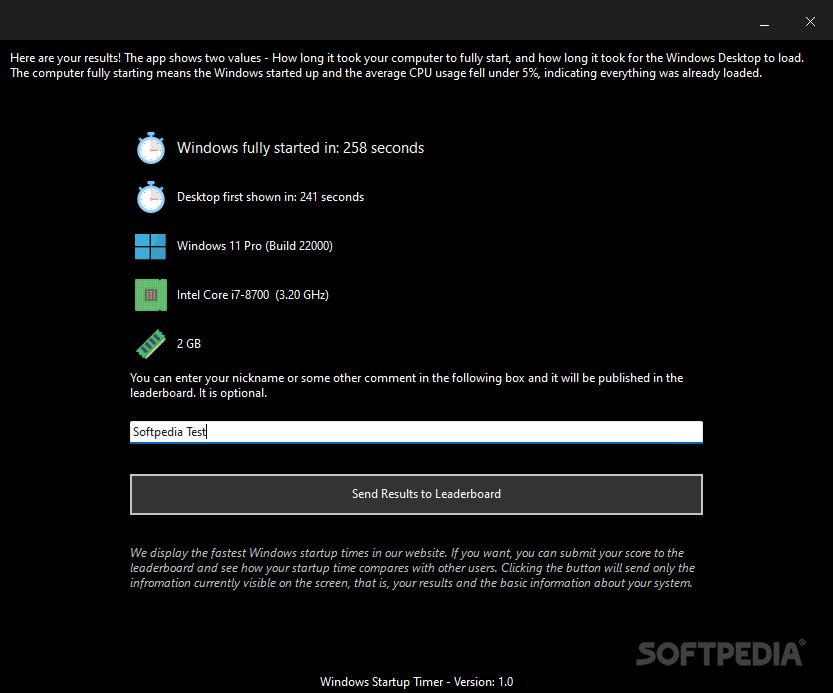
- Startup timer utility portable#
- Startup timer utility pro#
- Startup timer utility software#
- Startup timer utility password#
- Startup timer utility Pc#
Clicking the timer icon will immediately start a timer and there will be a toast reminder in the bottom right corner of your screen. Next to the Work Hours Entered, you see the timer icon. If you are a resource assigned to the task, you see the timer icon. There you can Add Timers and manage multiple timers The primary list of all timers is available in the top right corner of the navigation bar.
Startup timer utility portable#
Both portable and installer versions of Shutter Lite are available.This tool can be very useful for providing precise measurements of time spent on a task. The usual shutdown type actions are included along with monitor on/off, screensaver, screenshot, mute/unmute, alarm, text message, play a sound, run a program, open a file, close window, and kill process.
Startup timer utility pro#
While Shutter Lite is free and feature limited compared to the Pro version, it still allows you to set up a maximum of five presets, events, and actions. Help for that and an option to create a simple timed desktop shortcut are in the Help menu. There’s also the ability to run SleepTimer Ultimate from the Command Line or scripts. These range from forcing programs to close or closing the CD ROM tray to auto running a schedule on system startup, playing sounds, or showing on screen displays. If you want more control, there are dozens of settings in File > Preferences.

Just use the dropdown menus, define the action settings, and press Start Countdown. These include immediately perform the action, at a specific date/time, with a countdown timer, with an idle timer, with a window caption, on CPU load, on a schedule, or on a network traffic speed drop. There’s also a number of things you can do to trigger the action. This can be restart, power off, close/lock session, sleep, hibernate, and an admin restart or shutdown. You can create more advanced profiles which can have multi-conditional behavior meaning at least one or all conditions must be met for the computer to perform the shutdown type. The WinOFF interface has a lot of options on view at once which makes it look more complicated to use than it actually is. There’s also several command line options available.
Startup timer utility password#
Alternatively, you can also use the Serverless mode by using a remote user’s name and password instead of running the tool. You can do this while running DShutdown on both computers or running the included RDShutdown server side tool.
Startup timer utility Pc#
What to do to cause one of the above actions include countdown or date/time timers (including an AND button to trigger all three conditions), user inactivity monitor, screen pixel color change, window close monitor, process closed timer, various settings for network activity, CPU usage monitor, or shut down if a remote PC goes offline.Ī powerful feature for administration purposes is the ability to shut down remote computers. The Wise application also has a user-friendly interface with no complicated options or dialog boxes. Users can use the tool to shut down, restart, log off, hibernate, sleep, or lock the computer whenever they need to. The Auto Shutdown feature is a program that’s straightforward to use, with enough functionality to satisfy most users.
Startup timer utility software#
Wise software is popularly known for its disk/registry cleaners and data recovery tools. Here we have eight free tools that can perform simple shut down, reboot, or sleep operations, and can also be a bit more advanced if you require it.

It can be a hassle to go through learning to schedule tasks and use the shutdown tool if you only want to perform a simple shutdown now and again or require some extra features. Another option is to use the Windows Task Scheduler to do it and although not that difficult to set up, it’s not exactly a fast and efficient way to go for the average user. However, many users are not comfortable using the command prompt. In Windows, you can use the built in tool shutdown.exe from command prompt or a batch script to log off, shutdown, restart, or set a timeout for shutdown to xx seconds. Many tools don’t give you that option though and the computer has to be left on until you come back to it. A lot of modern software that performs time consuming tasks such as downloading or encoding will include some form of an option to shut down or sleep the computer once it’s finished.

Sometimes when you’re using your computer, you might have to leave it alone to complete a task before shutting it down or putting it to sleep.


 0 kommentar(er)
0 kommentar(er)
